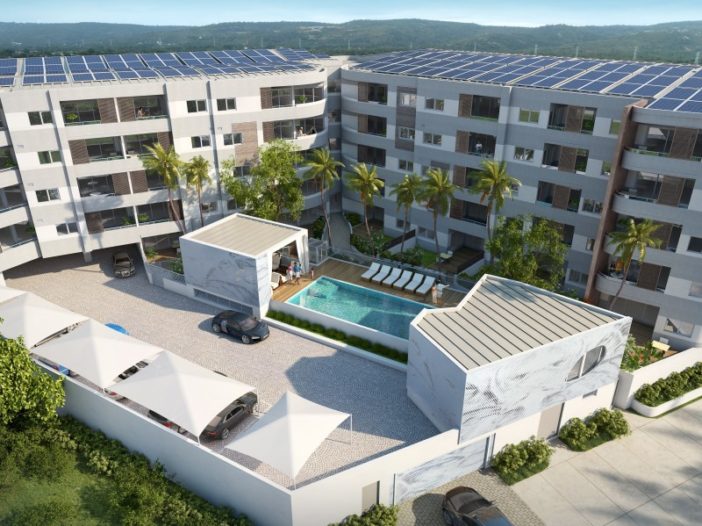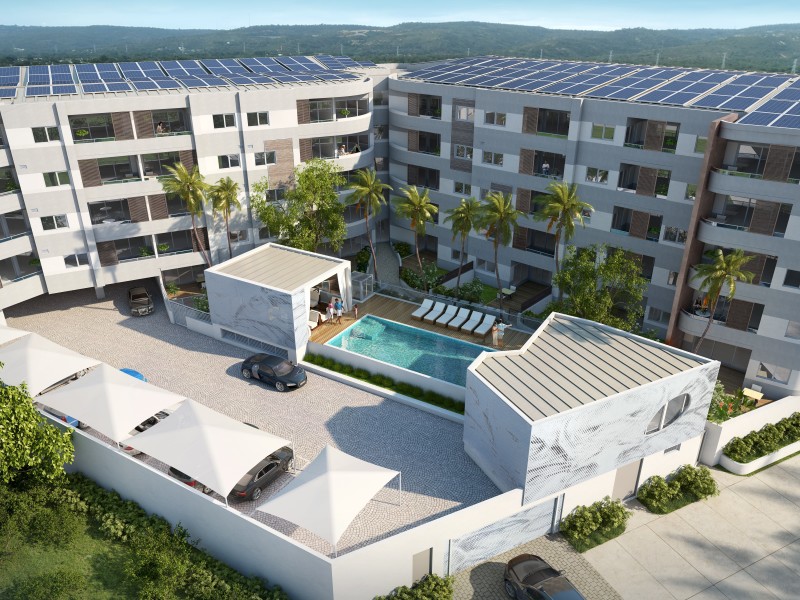
Rooftop solar might be a no-brainer for home owners with suitable roof space and a desire to reduce their electricity bills, but the equation gets a little more complex when applied to high density living. For many inner city and suburban apartment dwellers, there is no easy way to install PV panels, and so solar has not been a consideration.
But this is changing. As we have noted on this site before, for those who own or rent existing apartments, shared solar is opening up as an option for tapping into cheaper, cleaner energy. Meanwhile, developers of new apartment complexes are starting to see solar as an integral part of the design.
But how do you build solar into an apartment block?
One model we have seen used is the shared strata model, in which the solar (and possibly battery storage) system are owner-managed by the strata manager, and when an investor rents out an apartment, the tenant pays their (much reduced) electricity bill to the strata, which is used to offset the strata costs.
But Perth-based developers, Psaros, have taken a different approach. For  their recently completed 86-apartment project in Western Australia, the 180kW rooftop system is wired in such a way that it effectively gives each of the apartments its own 2kW PV array.
their recently completed 86-apartment project in Western Australia, the 180kW rooftop system is wired in such a way that it effectively gives each of the apartments its own 2kW PV array.
“The set-up is physically 2kW systems each,” Anthony O’Connell, the CEO of Metro Solar who installed the array, told One Step Off The Grid in an interveiw. “Each (2kW of solar panels) is physically wired down to each apartment.”
The builders were able to do this, and to keep all of the hardware accompanying the 640 solar panels on the apartment complex’s roof, by using advanced microinverter technology from US-based company, Enphase.
Indeed, they are using the same approach on another, even bigger project – another Perth apartment building – using 268kW of solar, which is expected to be finished by the end of the year, according to O’Connell.
“Flo Apartments is living proof of the incredible flexibility afforded by microinverter technology,” said Enphase managing director Asia Pacific, Nathan Dunn. “(They give developers) the ability to have a …system made up of 86 individual systems each allocated to one apartment – a design that is virtually impossible to achieve with a string inverter.
“This kind of flexibility in solar is essential in high density living, which is rapidly increasing in all major cities,” Dunn added in an emailed comment. “Enphase is proud to be making high performance solar and market-leading monitoring accessible to owners of apartments as well as standalone homes.”
And while O’Connell conceded that installing a system in this way was a lengthy and complex process (see video below) – and might not be a realistic option for existing apartment buildings – it was readily achievable on a new-build project, and had several upsides; not least of which being that it offered the future apartment owner, or renter, the same sort of energy independence a rooftop solar home owner might have.
Psaros Flo Solar Panel H264 from Psaros Property Group Pty Ltd on Vimeo.
Using this model, he said,”the solar is consumed depending on each person’s individual energy habits,” and people are encouraged to take an active interest in their energy consumption.
Tenants can do this using the Power Tracker system – a software program that gathers the data from the Enphase inverters and monitors each apartment’s consumption, compared with how much their panels are generating. The software also has a rating system, which allows people to compare how they’re tracking, on balance, with their neighbours.
This encourages a little bit of inter-apartment competition, says O’Connell, and thus encourages efficiency and smart energy use.
Another benefit, he adds, is that “if there was a problem with Unit 2’s system, it would only affect unit 2.”
 For Psaros, integrating solar power into a five-level, “boutique” development – along with smart technology that allows the apartment’s lighting, heating/cooling and entertainment systems to be controlled through the owner’s personal electronic device, such as an iPad – will fast become the new norm.
For Psaros, integrating solar power into a five-level, “boutique” development – along with smart technology that allows the apartment’s lighting, heating/cooling and entertainment systems to be controlled through the owner’s personal electronic device, such as an iPad – will fast become the new norm.
“Flo is really representative of the future direction of residential developments in Perth,” said Chiara Pacifici, the head of sustainability at Psaros.
“When you consider that more than two million Australian households are already fitted with solar panels, it won’t be long before the installation of renewable energy technology is standard across all new residential developments in WA,” she said.
“There’s overwhelming buyer support for projects incorporating renewable energy technologies, not only because of the cost-saving benefits, but also because people recognise this is the way of the future,” Pacifici said.

Sophie is editor of One Step Off The Grid and deputy editor of its sister site, Renew Economy. Sophie has been writing about clean energy for more than a decade.



